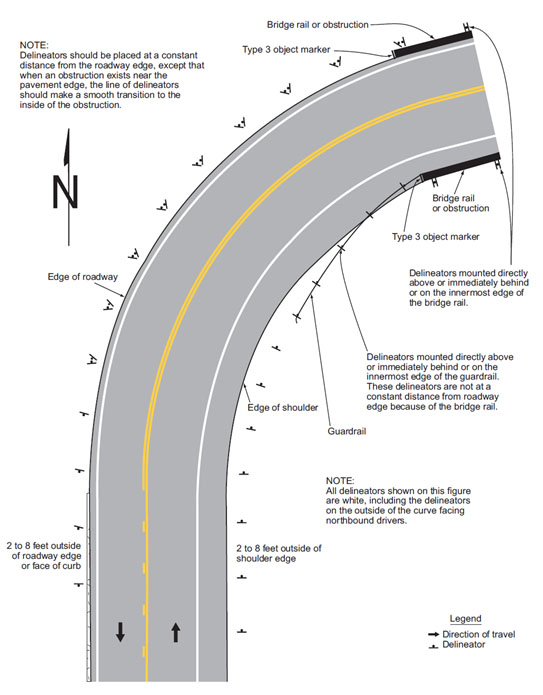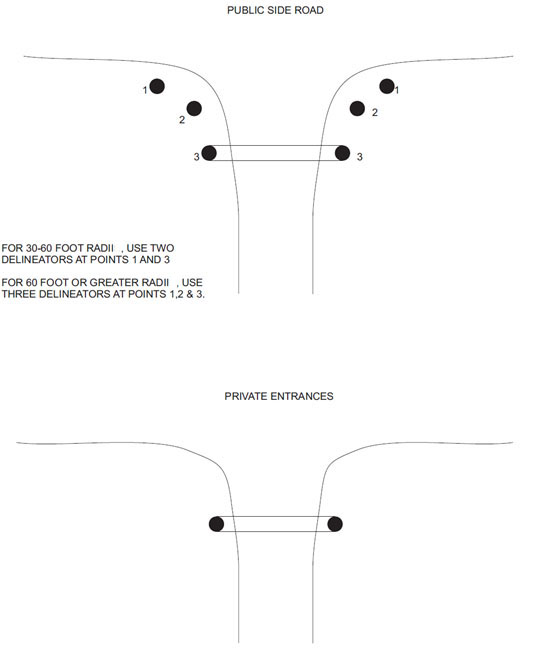620.5 Delineators (MUTCD Chapter 3F)
| Standard Plan |
| 903.03 Sheets 11 - 14 |
Contents
620.5.1 Delineators (MUTCD Section 3F.01)
Support. Delineators are particularly beneficial at locations where the alignment might be confusing or unexpected, such as at lane reduction transitions and curves. Delineators are effective guidance devices at night and during adverse weather. An important advantage of delineators in certain locations is that they remain visible when the roadway is wet or snow covered.
Delineators are considered guidance devices rather than warning devices.
Option. Delineators may be used on long continuous sections of highway or through short stretches where there are changes in horizontal alignment.
620.5.2 Delineator Design (MUTCD Section 3F.02)
Standard. Delineators shall consist of retroreflective devices that are capable of clearly retroreflecting light under normal atmospheric conditions from a distance of 1,000 ft. when illuminated by the high beams of standard automobile lights.
Retroreflective elements for delineators shall have a minimum dimension of 3 inches.
Support. Within a series of delineators along a roadway, delineators for a given direction of travel at a specific location are referred to as single delineators if they have one retroreflective element for that direction, double delineators if they have two identical retroreflective elements for that direction mounted together, or vertically elongated delineators if they have a single retroreflective element with an elongated vertical dimension to approximate the vertical dimension of two separate single delineators.
Option. A vertically elongated delineator of appropriate size may be used in place of a double delineator.
620.5.3 Delineator Application (MUTCD Section 3F.03)
Standard. The color of delineators shall comply with the color of edgelines stipulated in EPG 620.2.6 Edgeline Pavement Markings.
A series of single delineators shall be provided on the right-hand side of freeways and expressways and on at least one side of interchange ramps (see standard plans), except when either Condition A, Condition B or Condition C is met, as follows:
- A. On tangent sections of freeways and expressways when both of the following conditions are met:
- 1. Raised pavement markers are used continuously on lane lines throughout all curves and on all tangents to supplement pavement markings.
- 2. Roadside delineators are used to lead into all curves.
- B. On sections of roadways where continuous lighting is in operation between interchanges.
- C. On interstate or other highways with EPG 903.9.4 Emergency Reference Markers (D10-5).
Option. Delineators may be provided on other classes of roads. A series of single delineators may be provided on the left side of roadways.
Standard. Delineators on the left-hand side of a two-way roadway shall be white (see Fig. 620.5.4.1).
Option. Installation of delineators may be provided on public roads. A maximum of three delineators can be installed per approach as indicated in Fig. 620.5.4.2, Installation of Delineators on Public Side Roads and Private Entrances. Delineation of the right hand side of the radius may be provided by the use of Type 2 object markers installed on the STOP sign post if the post is located appropriately.
Guidance. A series of single delineators should be provided on the outside of curves on interchange ramps.
Where median crossovers are provided for official or emergency use on divided highways and where these crossovers are to be marked, a double yellow delineator should be placed on the left-hand side of the through roadway on the far side of the crossover for each roadway.
Double or vertically elongated delineators should be installed at 100 ft. intervals along acceleration and deceleration lanes.
A series of delineators should be used wherever guardrail or other longitudinal barriers are present along a roadway or ramp.
The use of Type 2 object markers on STOP sign posts should continue and be considered as part of side road delineation.
Option. A property owner may request the delineation of a private entrance.
When delineation is used at a private entrance the preference of the department is to have the property owners use white reflective tape, but we will permit other colors.
Standard. When delineation is used at a private entrance the owner will be responsible for the installation and maintenance of such delineation. MoDOT shall allow the installation of one lightweight post such as a metal fence post at each end of the pipe crossing or within the radius of the entrance. If reflectors are used rather than tape, one reflector on each side of the post, or a total of four reflectors, will be permitted.
Option. Red delineators may be used on the reverse side of any delineator where it would be viewed by a road user traveling in the wrong direction on that particular ramp or roadway.
Delineators of the appropriate color may be used to indicate a lane reduction transition where either an outside or inside lane merges into an adjacent lane.
Guidance. When used for lane reduction transitions, the delineators should be installed adjacent to the lane or lanes reduced for the full length of the transition and should be so placed and spaced to show the reduction (see Fig. Fig. 620.2.9.1).
Support. Delineators are not necessary for traffic moving in the direction of a wider pavement or on the side of the roadway where the alignment is not affected by the lane reduction transition.
Guidance. On a highway with continuous delineation on either or both sides, delineators should be carried through transitions.
Option. On a highway with continuous delineation on either or both sides, the spacing between a series of delineators may be closer.
Standard. Red delineators shall be used on the back side of delineators at off ramps to discourage wrong way driving. The red delineators shall be used starting at the crossroad and extending to the start of the deceleration lane on the main line.
620.5.4 Delineator Placement and Spacing (MUTCD Section 3F.04)
Guidance. Delineators should be mounted on suitable supports at a mount height, measured vertically from the bottom of the lowest retroreflective device to the elevation of the near edge of the roadway, of approximately 4 ft., see Standard Plans 903.
Option. When mounted on the face of or on top of guardrails or other longitudinal barriers, delineators may be mounted at a lower elevation than the normal delineator height recommended in the preceding paragraph.
Delineators should be placed 2 to 8 ft. outside the outer edge of the shoulder, or if appropriate, in line with the roadside barrier that is 8 ft. or less outside the outer edge of the shoulder.
Delineators should be placed at a constant distance from the edge of the roadway, except that where an obstruction intrudes into the space between the pavement edge and the extension of the line of the delineators. The delineators should be transitioned to be in line with or inside the innermost edge of the obstruction. If the obstruction is a guardrail or other longitudinal barrier, the delineators should be transitioned to be just behind, directly above (in line with), or on the innermost edge of the guardrail or longitudinal barrier. Channel post mounted delineators should not be installed behind guardrail if guardrail delineation is present.
Delineators should be spaced 200 ft. to 530 ft. apart on mainline tangent sections. Delineators should be spaced 100 ft. apart on ramp tangent sections.
Support. Examples of delineator installations are shown in Fig. 620.5.4.1, Examples of Delineator Placement.
Option. When uniform spacing is interrupted by such features as driveways and intersections, delineators which would ordinarily be located within the features may be relocated in either direction for a distance not exceeding one quarter of the uniform spacing. Delineators still falling within such features may be eliminated.
Delineators may be transitioned in advance of a lane transition or obstruction as a guide for oncoming traffic.
Guidance. The spacing of delineators should be adjusted on approaches to and throughout horizontal curves so that several delineators are always simultaneously visible to the road user. The approximate spacing is shown in the Approximate Spacing for Delineators on Horizontal Curves Table.
| Radius of Curve, R ft. | Approximate Spacing on Curve, S ft. |
|---|---|
| 50 | 20 |
| 115 | 25 |
| 180 | 35 |
| 250 | 40 |
| 300 | 50 |
| 400 | 55 |
| 500 | 65 |
| 600 | 70 |
| 700 | 75 |
| 800 | 80 |
| 900 | 85 |
| 1,000 | 90 |
| Distances were rounded to the nearest 5 ft. | |
| Spacing for specific radii may be interpolated from table. The minimum spacing should be 20 feet. The spacing on curves should not exceed 300 feet. In advance of or beyond a curve, and proceeding away from the end of the curve, the spacing of the first delineator is 2S, the second 3S, and the third 6S but not to exceed 300 feet. S refers to the delineator spacing for specific radii computed from the formula (Formula applies to measurements in feet only). |
620.5.5 Guardrail Delineation
Standard. All guardrail shall be delineated in accordance with Section 606.10.2.3 of the Standard Specifications. The design of the guardrail delineators shall be in accordance with Standard Plans 903 and Standard Specification Sec 1065. The color of the retroreflective sheeting used shall match the color of the adjacent edgeline. If no edgeline is present, white shall be used on the right side facing approaching traffic.
On two-lane roads with two-way traffic the guardrail shall be delineated with white retroreflecitve sheeting on both sides of the delineator, including at bridge approaches.
Standard. If guardrail is present at off ramps, the back side of the guardrail delineator shall be red retroreflective sheeting. The red sheeting is used on the back side of guardrail delineators from the crossroad to the start of the deceleration lane on the main line.
Option. The use of the red sheeting on the back side of guardrail delineators may be used wherever there is a need to discourage wrong way driving.
620.5.6 Barrier Wall Delineation
Standard. Permanent barrier walls and bridge barrier walls shall be delineated in accordance with Section 617.30 of the Standard Specifications. The design of barrier wall delineators shall be in accordance with Standard Plan 903.03 and Standard Specification Sec 1065. The color of the barrier delineators shall match the color of the adjacent edgeline.
Guidance. Where there is traffic on both sides of a barrier wall, a two sided delineator with retroreflective sheeting on both sides, should be used. On two-lane roads the bridge barrier walls should be delineated with white retroreflective sheeting on both sides of the delineator.
Standard. If a barrier wall is present at off ramps, the back side of the barrier wall delineator shall be red retroreflective sheeting. The red sheeting is used on the back side of barrier wall delineators from the crossroad to the start of the deceleration lane on the main line.
Option. The use of the red sheeting on the back side of barrier wall delineators may be used wherever there is a need to discourage wrong way driving.



